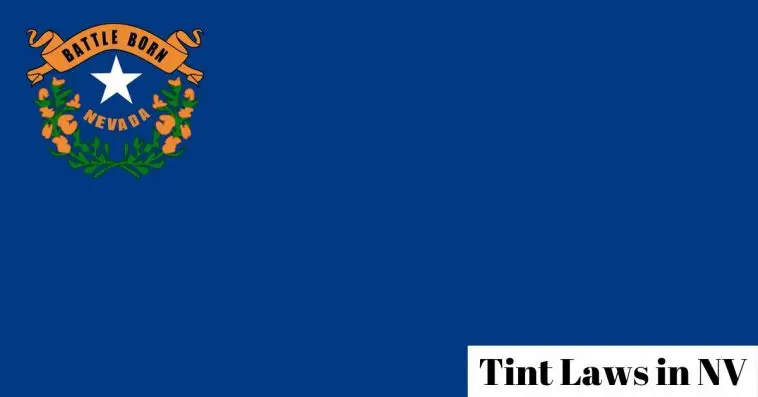Window tinting laws vary in different states; that’s why it’s important to equip yourself with relevant updated laws on each state. If there’s no adherence to these laws, it can result in heavy fines and unpleasant encounters with law enforcers.
In this article, I have highlighted the important information you need to know about Nevada’s laws on car window tinting while answering some of the questions you may have.
Let’s get to it!
TABLE OF CONTENTS
Are You Allowed To Have Tinted Windshield And Windows In Nevada?
Nevada’s current laws regulating car window tinting were put in place in 1993 to ensure the safety of car users on the road, especially at night and misty days.
In Nevada, you can tint your car’s windows, including the windshield. However, some laws give clear direction on the required Visual Light Transmission (VLT %) percentage for each car type.
The windshield is allowed a non-reflective tint, which should be put above the AS-1 line indicated by the manufacturer. The tint allowed on the front side windows should allow over 35% of light to pass through it.
The rear and backside windows do not have any restrictions to how dark the tint should be so that you can choose any tint darkness of your choice. The law restricts the use of Red and Amber tint colors on any vehicle in any circumstance.
What Is The Darkest Tint You Can Legally Get In NV?
The darkest tint allowed is 35%, meaning the tint must allow more than this percentage of light into the car. This restriction applies to front side windows only.
The windshield requirements are such that the tint must be non-reflective, and the tinted area should be above the AS-1 line indicated by the manufacturer. This line is usually about 8 inches from the top of the windshield.
Is 20 Tint Illegal In NV?
A maximum 20 % tint is allowed only as a medical exemption. There are medical conditions that can lead to such an exemption, but you’ll have to apply for it.
We’ll discuss how you can get a medical exemption further in this article.
Window Tint Darkness In Nevada
The window tinting laws in Nevada are clear on what is expected as far as tint darkness is concerned. It’s measured as a percentage of the Visible Light Transmitted through the glass and the tint film. It’s symbolized as VLT %.
For Passenger Vehicle
- Windshield – Non-reflective tint is allowed, but it should not cross the AS-1 line of the windshield.
- Front Side Windows – A 35% tint is acceptable on the passenger side windows so that they can pass more light in the vehicle.
- Back Side Windows – There are no restrictions on how dark the tint on the back side windows should be. You can apply a tint with any darkness level you choose.
- Rear Window – There are no restrictions on how dark the tint on the rear window should be. You can apply a tint with any darkness level you choose.
Examples of passenger vehicles are sedan, hardtop, convertible, station wagon, coupe, and hatchback vehicles.
For Multi-Purpose Vehicle
- Windshield – Non-reflective tint is allowed, but it should not cross the AS-1 line of the windshield.
- Front Side Windows – A 35% tint is acceptable on the passenger side windows so that they can pass more light in the vehicle.
- Backside Windows – There are no restrictions on how dark the tint on the backside windows should be. You can apply a tint with any darkness level you choose.
- Rear Window – There are no restrictions on how dark the tint on the rear window should be. You can apply a tint with any darkness level you choose.
Examples of multi-purpose vehicles are SUVs, minibusses, vans, pickups, and RVs.
Window Tint Reflection in Nevada
The tinting film is made with some metallic elements to reflect the visible light and the heat generated as the light crosses the glass medium.
For Passenger Vehicle
- Front Side Windows – There are no restrictions on the Nevada tinting laws about tint film reflectivity.
- Back Side Windows – There are no restrictions on the Nevada tinting laws about tint film reflectivity.
For MPV (Multi-Purpose Vehicle)
- Front Side Windows – There are no restrictions on the Nevada tinting laws about tint film reflectivity.
- Backside Windows – There are no restrictions on the Nevada tinting laws regarding tint film reflectivity.
How Do You Get A Medical Exemption For Window Tint In Nevada?
Medical exemptions in relation to window tints can be issued if the medical condition requires a darker tint. In some cases, the windshield can have a 50% tint; the side windows can have a 20% tint, while the backside windows can have a 5% tint.
In Nevada, medical exemptions are allowed as long as a physician recommends it as a requirement to manage your health condition. Most medical exemptions expire after a period of four years, and you can request for renewal if it’s still needed.
The State of Nevada will require you to fill out an application form that captures your details, car details, and contact information in section 1.
The second section is filled by a registered and licensed physician in the State of Nevada. It requires a diagnosis explaining the condition and the recommended VLT %.
The physician will indicate whether the condition is permanent or temporary to determine the expiry period for the license.
The department of public safety considers the application and approves it if it meets all the requirements. It would be best if you always remembered to carry it with you whenever you’re using your car to avoid unpleasant encounters with highway patrol police.
You should also note that if at some point you sell the car registered for window tint medical exemption, this exemption doesn’t transfer to the new owner. You’ll need to report it so that appropriate corrections are made.
Conclusion
Nevada’s laws on car window tinting are flexible enough to allow you to enjoy tinting your car with your preferred tint. You can use tint in any color except red and amber.
If at any point you find these tinting laws complicated, take time to understand them and get tinting services from experienced and professional people so that they can do everything according to the law.




